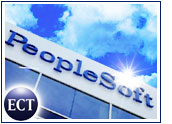
In a recent white paper, Denis Pombriant, vice president and research director of CRM at Aberdeen Group, wrote that salesforce.com’s sforce 2.0 application platform “could do for application development and the software business in general what salesforce.com’s CRM product has done for CRM. If that is so, it will be sforce rather than hosted CRM that is the true disruptive innovation.”
“What we are seeing is the changing of the guard, with the hosted model challenging the license model for supremacy,” Pombriant told CRM Buyer.
“Hosted applications have been the Rodney Dangerfields of integration in the enterprise; they never get any respect,” AMR Research senior analyst Louis Columbus said in an interview with CRM Buyer. However, he said, “sforce is going to show how a service-oriented architecture can work in a hosted delivery model. The bottom line? Depth of application matters more than delivery method.”
Will sforce save enterprises from the morass of expensive, complex, hard-to-integrate CRM software?
Managing the Talent
Canal Street Talent is a San Francisco-based executive search firm that has taken basic aspects of the traditional Hollywood talent model and applied it to C-level executives, vice presidents and other high-level professionals. Instead of working for companies the way headhunters typically work, Canal Street represents executives, finding them roles in management, on boards and for speaking engagements.
To place their clients, Canal Street agents track an immense amount of data and must be able to generate reports quickly, Jeff Hyman, chief talent agent at Canal Street, told CRM Buyer. His firm needed a CRM solution that could track compensation dates, boards on which clients might sit, client resumes and other key data in the most customizable, flexible way possible. However, because Canal Street has only four employees, buying traditional licensed CRM software was not a realistic option.
Instead, Canal Street signed up with salesforce.com. Hyman said the one thing missing from salesforce.com’s service was that it only offered one main database. Although he called that database flexible and customizable, he noted that Canal Street needs two databases to work effectively.
“In our business, we go through two sales processes,” he said. “We sign up clients, and we find jobs for these clients.”
Enter sforce. Using the new platform, Canal Street gained the ability to build and add on to salesforce.com’s existing system. The firm worked with a small software company to build out the second database. Hyman called the process “very easy.”
K.I.S.S. Strategy
Indeed, sforce is highly customizable. “If you want to build a paperclip management system that is optimally shareable across the Internet and hosted environment, sforce can make it happen,” Pombriant said.
Sheryl Kingstone, program director and senior analyst of CRM strategies at the Yankee Group, told the E-Commerce Times that people who are frustrated with licensed CRM offerings from giants like Oracle and Siebel are ready to move on to something new and much more flexible to manage. Salesforce.com and its sforce environment can provide those people with a lot of functionality for application development.
“It’s so easy to use. In the ’90s we dug a hole for ourselves, making software that was difficult to use, over-customized, too expensive,” Kingstone said. “It’s almost as if we have to go back to ground zero and start over again. ‘KISS,’ or ‘Keep It Simple, Stupid,’ is a good thing to keep in mind for IT and technology development.”
The Next Frontier
According to sforce product manager Adam Gross, salesforce.com is moving beyond the traditional CRM dichotomy, which required businesses to choose either a massively expensive and complex CRM offering that could be difficult to implement or a first-generation application service provider (ASP) whose offering was significantly cheaper but more limited than a full-blown in-house solution.
Instead of forcing such a decision, salesforce.com merges the benefits of both options, Gross told CRM Buyer in an early December interview, explaining that sforce users can get easy-to-implement, custom-tailored systems at low cost.
“Salesforce.com’s roots and heritage are on the on-demand side, and with that in mind, we have invented a whole bunch of really interesting technology with a very sophisticated degree of customization,” he said. “We believe it is the next frontier, [offering] the benefits of an outsourced system that is completely under your IT and developers’ control.”
The Linux Effect
Sforce stands to have a huge impact on salesforce.com, Pombriant said. Its arrival puts the company in immediate competition with other development environment vendors and could generate what he called the “Linux Effect,” in which developers would build out sforce’s product set without salesforce.com having to make much of an investment.
Similarly, salesforce.com could end up recruiting and enlisting software developers who would create applications for the sforce platform.
“A developer might come to the company and say, ‘I want to build a solution for xyz vertical market.’ Now [salesforce.com has] a vertical market solution where [it] didn’t have one before,” Pombriant said.
Going After the Big Fish
So far, it looks as if this strategy may be a winning one. Kingstone noted that salesforce.com is starting to win customers away from traditional CRM vendors like Siebel and PeopleSoft, in part because sforce is customizable and integrates well with existing systems.
“The question [now] is, with the introduction of Siebel OnDemand, will salesforce.com continue to take customers away?” she said.
AMR Research’s Columbus said sforce will certainly help make salesforce.com more competitive with the big vendors.
“If sforce succeeds, the decision by salesforce.com users to move off the hosted model to licensed software goes away,” he noted. “But all is not totally blue sky here; consider order management on a hosted platform, for example. Deep integration with ERP systems is going to still favor licensed software.”
Dumping the Client/Server Paradigm
Gross said salesforce.com sees itself competing on the architecture or style of building things rather than with specific vendors. In fact, on its sforce Web site, salesforce.com offers developer toolkits for Microsoft Visual Studio, .NET and Java, among others.
Vendors like Microsoft, BEA, Borland and Sun Microsystems have embraced and are investing heavily in Web services, Gross added. Those companies are rallying around the sforce model, believing on-demand is the direction in which application development is headed.
“The client-server model is not a modern [architecture],” he said. “It’s similar to mainframes. People still make use of them, but no one’s going out for new ones.”




















































Social CRM
See all Social CRM